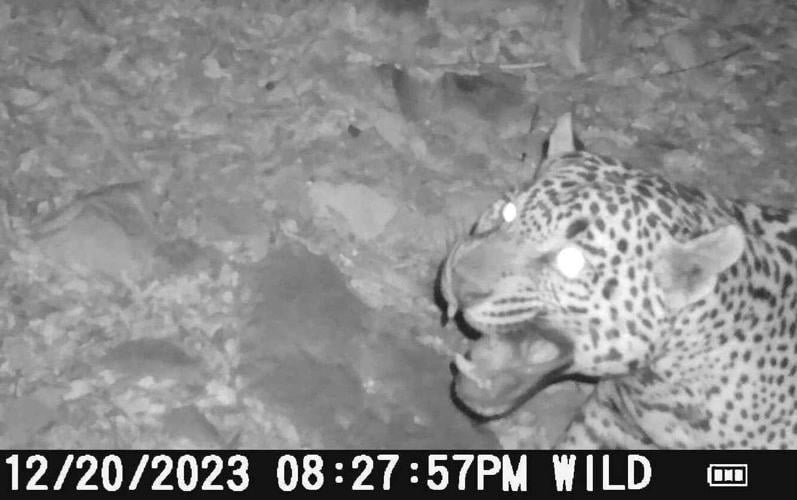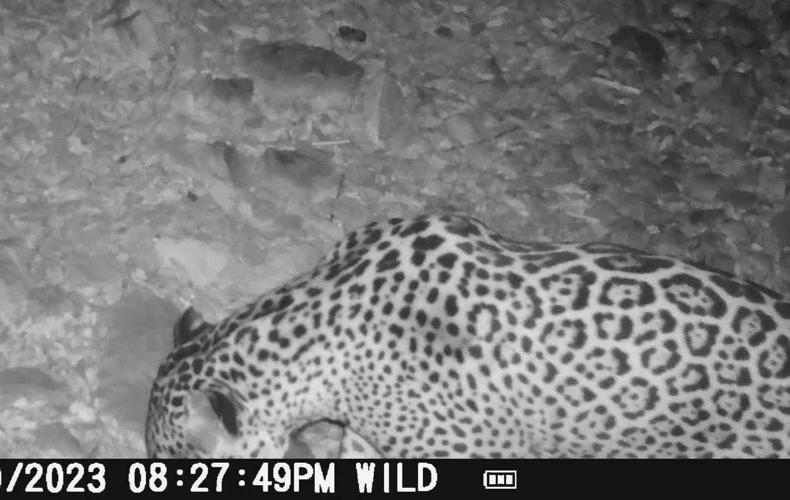There’s a new jaguar roaming the mountains of Southern Arizona, state wildlife officials and the Center for Biological Diversity confirmed.
The Tucson-based environmental group announced Friday that an analysis of recent trail camera video shows the presence of a jaguar not previously identified in the United States.
Later Friday, the Arizona Game and Fish Department confirmed the jaguar, videotaped in the Huachuca Mountains, is different from any documented in the state before.
The footage was captured on Dec. 20 by Vail wildlife videographer Jason Miller, who said he set up his motion-activated cameras in “a deep canyon” in the mountain range near the U.S.-Mexico border.
He released the images on his YouTube channel Wednesday night.
The distinctive rosette pattern on the animal in Miller’s video does not match the markings on El Jefe or Sombra, the two jaguars most recently documented north of the border, said Russ McSpadden, a Southwest conservation advocate for the enter for Biological Diversity.
A new video on the Jason Miller Outdoors YouTube account shows a jaguar filmed in an undisclosed mountain range in Southern Arizona on Dec. 20.
“Every new jaguar in Arizona is a moment to celebrate,” said McSpadden in a written statement.
“We’re extremely lucky to live near such magnificent creatures, and we’ve got to do everything we can to protect our shared landscape.”

The Tucson-based Center for Biological Diversity compared the distinctive rosette patterns on three jaguars photographed in Arizona to determine that a cat caught on video last month, top, is a new one not previously documented in the state.
Jaguars once ranged as far north as Colorado and Northern California and as far east as Louisiana before being hunted nearly to extinction in the U.S. by the middle of the 20th century.
The jaguar filmed by Miller is just the eighth individual documented in the Southwest in almost 30 years.
Center officials said it could be the same animal photographed at least twice last spring by remote cameras operated by U.S. Customs and Border Protection in the Huachuca Mountains southwest of Sierra Vista. Those images were too blurry to identify the jaguar.
The other seven cats identified in Arizona and New Mexico since 1996 have all been males that most likely wandered north from a breeding population in Sonora, Mexico.

A screen shot from a trail camera video shows the distinctive spots on a jaguar that a wildlife videographer documented in Southern Arizona on Dec. 20.
No females have been recorded in the U.S. since an Arizona hunter killed one in the White Mountains in 1963.
Miller’s video does not show enough of the cat to determine its sex, but it doesn’t matter either way according to Megan Southern, jaguar recovery coordinator with The Rewilding Institute, an Albuquerque, New Mexico-based conservation group.
“Whether male or female, this new jaguar is going to need a mate,” Southern said. “Now is the time for us to have a serious conversation and take action to bring jaguars back.”
The largest cat in the Americas has been on the federal Endangered Species List since 1997, when it was added in response to legal action by the Center for Biological Diversity.
In 2022, the center petitioned the U.S. Fish and Wildlife Service to reintroduce jaguars to the U.S. and dramatically expand the cat’s federally designated critical habitat, which is currently limited to areas south of Interstate 10 through Southern Arizona and New Mexico.
McSpadden said this most recent sighting of a new individual in Arizona underscores both the viability and fragility of the isolated, “sky-island” mountain ranges the animal calls home.
“After being nearly wiped out, these majestic felines continue to reestablish previously occupied territory despite border wall construction, new mines and other threats to their habitat,” he said.
Miller declined to identify the mountains where the jaguar was filmed.
He said he set up the camera that caught the animal on Dec. 2 near a “scrape” on the forest floor where a mountain lion had left its scent. He first saw the surprising footage on Dec. 30, when he went back to check on his equipment.
“It blew me away,” he said. “I was so on cloud nine, I was shaking. I could barely hold the camera steady” to shoot the rest of the YouTube video.
Miller said he started placing trail cameras on public land across Southern Arizona about five years ago because he wanted to record all the wild animals our region has to offer.
“The ultimate holy grail would be to get a jaguar, an ocelot or a jaguarundi,” he said.
Miller has captured video of two out of the three so far. In July, two of his motion-activated wildlife cameras in the Huachucas caught footage of the only known ocelot in Arizona.
“I think it’s awesome that there’s still opportunities for rare things to come up from Mexico and for us to get to see them,” Miller said.
He plans to keep at it, too. His recent success has only made him hungrier.
“It’s not like I got him and I’m done,” the videographer said. “I want more of the jaguar.”







